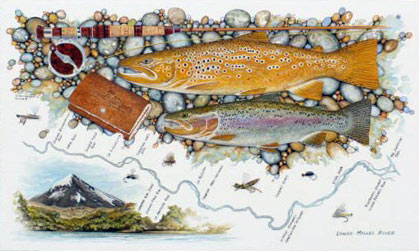Bull Trout, November 2012, Fish of the Month!
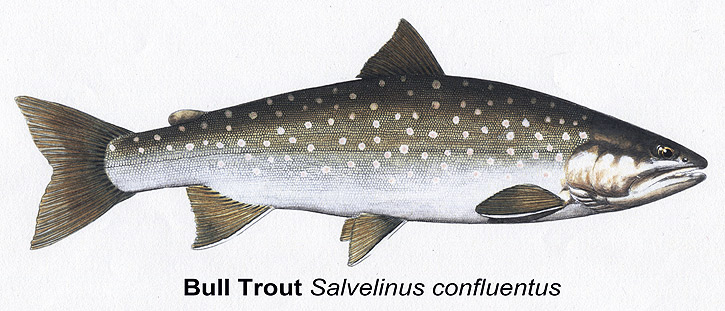
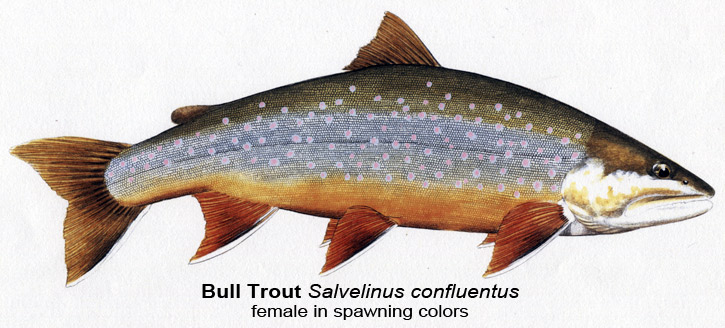
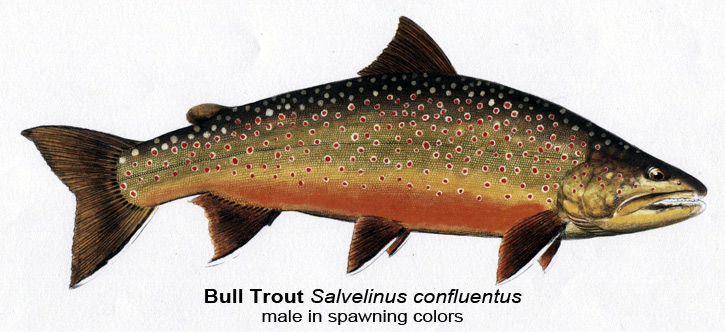 Bull Trout
Bull Trout
Salvelinus confluentus
Local Names:
Pacific Brook char
Red-spotted char
Red-spotted trout
Western Brook char
Western Brook trout
Average Size:
12 to 24 inches
1 to 8 pounds
Distinguishing Field Marks:
Color and color pattern are reliable distinguishing field marks for this species. (See the illustrations.)
-
The Bull trout is easy to distinguish from other trout and chars because of its elongated rather flattened head.
-
The mouth is very large with the upper jaw extending well beyond the rear edge of the eye.
-
There are no spots on the fins, even in breeding specimens.
-
The tail fin is moderately forked, with a slender caudal peduncle.
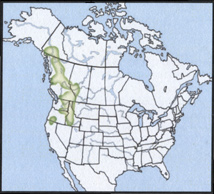
-
The pectoral, pelvic, and anal fins often have white outside thin black leading edges. The white is more distinct in spawning adults and the lower edge of their tail fins also often show white.
-
The anal fin has 8 to 11 principle rays.
North American Range:
Map to the right shows approximate range in North America.
Diet:
Bull trout fry consume zooplankton, parr consume immature and adult aquatic insects, and adults eat mainly fishes.
Biology:
Bull trout spawn in late summer and early fall at water temperatures of 45 to 50 degrees F (7.25 to 10.00 degrees C.). The spawning act is similar to that of other salmonid species. The number of eggs carried by females depends on their size, and ranges from 200 to 12,000. Immediately after spawning, adult Bull trout move downstream to deeper water, either in the same river system or into a lake.
In the warmer water temperatures of fall, early development of the eggs is quite rapid, but slows considerably as winter asserts itself and stream water temperatures drop to near freezing.
The eggs usually hatch in mid-winter, but the alevin remain in the nest gravel until April before they swim-up as fry, having absorbed their yolk sacs. Bull trout usually remain in their natal streams for 1 to 4 years, although some individuals may spend their entire lives there. Those that leave their birth streams move downstream to larger portions of the river system, or into lakes to which the streams are tributary.
Adults that live in large lakes can attain weights of about 15 pounds (6.75 kg.) and lengths of 34 inches (86.25 cm.). Those that remain in smaller streams usually do not grow much larger than 1 to 2 pounds (0.50 to 1 kg.) and 14 to 16 inches (35.50 to 40.75 cm.).
Fly Fishing for Bull Trout:
Bull trout are aggressive and easy to catch. They grow to impressive size and offer the fly fisher a relatively easy opportunity to hook and play a large fish. Bull trout continue to be thought of as efficient predators of other salmonids. They readily hybridize with introduced exotics (especially Brook trout). Nevertheless, with all their positive sporting qualities considered, it is very impotant to keep in mind that Bull trout numbers and range have been significantly reduced in all areas where they were formerly abundant. Many watershed-specific populations of bull trout are now extinct. Of those remaining, all are threatened. It is illegal to kill Bull trout in most of their range, and required that all incidentally caught bull trout be immediately released.
Unless you are absolutely certain that you are legally fishing for the species, we recommend that you refrain from actively pursuing Bull trout. In any case, release all Bull trout you catch as your contribution to maintaining what few are left of this western char.
Again, an internet search can easily inform anyone about the best places to legally fish for Bull trout.
Fly fishing for these big char will necessitate the use of 7 to 9 weight outfits. Their fish diet will attract them to large wet and streamer flies.
Significance to Humans:
Considered by many as no more than a nuisance, Bull trout were caught and simply left to die or consumed by those anglers who caught them. They are good game fish, although not as spectacular when hooked as rainbow trout, and far less selective than brown trout. Sadly, their reputation was established before the term "eco-system" became part of the anglers' vocabulary and we have begun to value the place of native species throughout the world. Sadly, Bull trout populations have become only a very pale shadow of what they once were.
We might think of this char's significance to humans as an indicator of how easy it is to decimate a fish species. We might also consider the recent resurgence of Canada geese, Snow geese, and Striped bass under conservation-based regulations as indicators of what can take place in the future.
Status:
Depending on the watershed; extinct, threatened, or tenuous. Extensive Bull trout restoration efforts are underway throughout the specie's range, but, in order to meet with any measurable success, these will require research, large sums of money, education, and sportsmens' cooperation.




